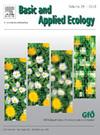Recent biodiversity changes in grasslands across elevational bands in Switzerland
IF 3.5
2区 环境科学与生态学
Q2 ECOLOGY
引用次数: 0
Abstract
Concerns about intensification of land use and land abandonment threatening plant diversity called for the establishment of national monitoring and agri-environmental payment schemes in Switzerland. Yet, little is known about recent biodiversity changes in Swiss grasslands. The analyses in this study were based on the presence / absence records of 455 permanent 10 m2 plots in grasslands systematically spread across elevational bands in Switzerland, collected by the Swiss Biodiversity Monitoring BDM. We assessed changes in vascular plant species richness, mean ecological indicator values and species composition at the local scale in Swiss grasslands over two decades (2001–2023) and for three elevational sets (all, below, and above 1200 m a.s.l.). Further, we identified winners and losers at the species level. Throughout all three elevational sets, we found that the mean species richness increased in the study period. Likewise, the mean ecological indicator values for temperature increased throughout. While the mean ecological indicator values of nutrient, soil moisture and reaction remained constant for the set of all plots, at lower elevations there was a trend towards a decreased nutrient value whereas soil moisture decreased at higher elevations. Overall, more species showed positive rather than negative trends over time. Especially at lower elevations, short-lived, ruderal species and C4 grasses are on the increase. We suggest that these trends are linked to the increased harvesting frequency and the recent trend towards longer dry spells in Swiss summer. By contrast, at higher elevations, stress tolerance of grasslands decreased while competitiveness increased. These diverging patterns point to different drivers of biodiversity change dependent on elevation and call for context-dependent conservation measures.
瑞士各海拔带草原生物多样性的近期变化
对土地利用集约化和土地放弃威胁植物多样性的关切要求在瑞士建立国家监测和农业环境支付计划。然而,人们对瑞士草原最近生物多样性的变化知之甚少。本研究的分析基于瑞士生物多样性监测BDM收集的455个分布在瑞士不同海拔带的永久性10 m2样地的存在/缺失记录。研究了2001-2023年间瑞士草原维管植物物种丰富度、平均生态指标值和物种组成在局地尺度上、海拔高度分别为1200 m以下和1200 m以上的变化。此外,我们在物种水平上确定了赢家和输家。3个海拔集的平均物种丰富度在研究期间均呈上升趋势。温度的生态指标值也呈上升趋势。所有样地的养分、土壤水分和反应的平均生态指标值保持不变,但在低海拔有养分值下降的趋势,而在高海拔有土壤水分下降的趋势。总的来说,随着时间的推移,更多的物种呈现出积极的趋势,而不是消极的趋势。特别是在低海拔地区,短生、粗生和C4禾本科植物呈增加趋势。我们认为,这些趋势与收获频率的增加和瑞士夏季干旱期延长的趋势有关。高海拔草原的抗逆性降低,竞争能力增强。这些不同的模式表明,生物多样性变化的驱动因素不同,取决于海拔高度,需要采取因地制宜的保护措施。
本文章由计算机程序翻译,如有差异,请以英文原文为准。
求助全文
约1分钟内获得全文
求助全文
来源期刊

Basic and Applied Ecology
环境科学-生态学
CiteScore
6.90
自引率
5.30%
发文量
103
审稿时长
10.6 weeks
期刊介绍:
Basic and Applied Ecology provides a forum in which significant advances and ideas can be rapidly communicated to a wide audience. Basic and Applied Ecology publishes original contributions, perspectives and reviews from all areas of basic and applied ecology. Ecologists from all countries are invited to publish ecological research of international interest in its pages. There is no bias with regard to taxon or geographical area.
 求助内容:
求助内容: 应助结果提醒方式:
应助结果提醒方式:


